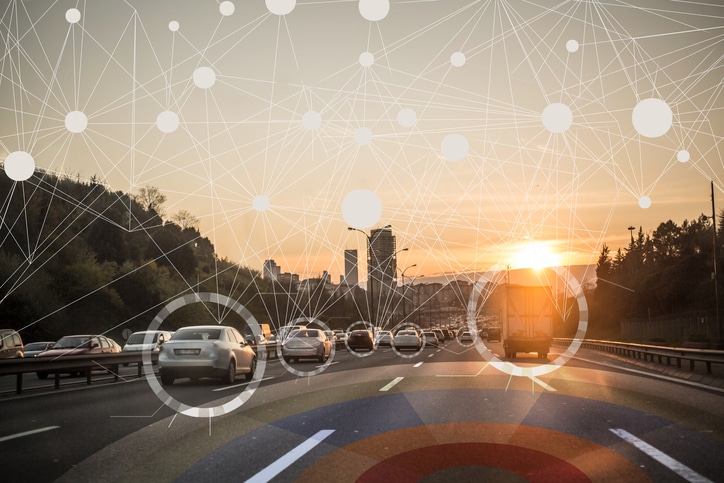There’s been a lot of hype in the media about driverless cars and connected cars, with manufacturers, experts, even politicians, weighing in on the debate. And, while most see these cars as the future of the automotive industry, it’s hard to know which is the best, most practical option. So, what are the differences between the two, and which, if any, are we going to see driving up and down UK roads in the years to come?
Quick links:
- What is a Connected Car?
- What are the Benefits of a Connected Car?
- How are Connected Cars Different from Driverless Cars?
- What is a Driverless Car?
- When Can We Expect to See Driverless Cars on UK Roads?
- Why Are Big Companies so Keen to Perfect a Driverless Car?
- Are Driverless Cars Really Safer?
- What Does the Future Hold?

What Is a Connected Car?
A connected car uses the internet to access various apps, software packages and plugins to enhance your driving experience. Chances are you’re already driving one, and experts predict there will be more than 200 million on the roads by 2020.
What Are the Benefits of a Connected Car?
Connected tech allows our cars to communicate with the outside world, interact with each other, and receive up-to-the-minute information on road conditions, traffic and weather. Here are few other areas where connected cars have made giant leaps in the past few years:
- Safety. Your connected car can alert you to imminent collisions, hazards in the road, and plot safer, quicker routes; it’ll even let the emergency services know if you’re involved in an accident.
- Reliability. Today’s connected car monitors your car like never before, assessing wear and tear on parts, and alerting you to any potential mechanical issues or imminent breakdowns.
- Infotainment. Cutting-edge software, like Apple CarPlay, allows you to integrate your smartphone with your car’s infotainment system, mirroring your phone’s display on your in-dash screen.
- Security. Your connected car is better protected than ever, with apps to disable your ignition, slow down the engine to prevent high-speed chases, and track your stolen car to any location.
So How Are Connected Cars Different From Driverless Cars?
The difference between the two cars is the level of involvement the driver has.
In connected cars, we might be able to use remote parking and route guidance, but the driver still has ultimate control. In a driverless car, you’re in the passenger seat letting the car do the decision making.
What Is a Driverless Car?
Driverless cars are vehicles that are able to operate completely independently of a human driver, using sensors, cameras, radar and AI to get passengers safely from A to B. To be considered autonomous, your self-driving car must be able to negotiate public roads without any human interference, using advanced image recognition techniques to identify other road users, avoid obstacles, and get you to your destination in one piece.
Once the stuff of science fiction, driverless cars are fast becoming a reality, with companies like Google and Ford pumping billions into their development.
So When Can We Expect to See Driverless Cars on UK Roads?
Tech giants and car manufacturers have been trialling connected cars for the best part of a decade, but, as of today, a truly driverless car is still a few years off.
Self-driving cars aren’t commercially available, and, while systems like Tesla’s Autopilot allow hands-free driving under controlled conditions, nobody, as yet, has been able to perfect a driverless system that entirely takes human beings out of the loop.
In all versions of the latest self-driving tech, we, the driver, still have an integral part to play, whether that’s intervening to prevent a collision, or taking over when unexpected road conditions arise, such as detours or roadworks. And, before we get to sit back and let our virtual chauffeur take the wheel, there are still a number of important milestones that need to be reached.
Why Are Big Companies So Keen to Perfect a Driverless Car?
While there’ll always be sceptics, there are real advantages to autonomous driving, along with some real-world benefits. Top of the list is cleaner air. A world filled with driverless cars, passing each other in the night, is good news for the environment.
All autonomous cars being developed today are either hybrids or electric, and that will undoubtedly have a huge impact on emission levels in the future. Another big selling point is safety. According to UK police, the majority of fatalities on our roads are down to driver error, so in theory, any transport system that takes human beings out of the equation should make for safer roads.
Are Driverless Cars Really Safer?
The problem is, until manufacturers perfect autonomous travel, talk of improved safety is little more than speculation. And there have been some high-profile setbacks.
In March this year, Uber was trialling their latest driverless prototype on the streets of Arizona, when unfortunately the car failed to recognise a woman wheeling her bicycle across the street, and she was killed instantly. Uber suspended any future testing on public roads, but this sadly is not an isolated case; just days later, a man piloting a semi-autonomous vehicle was killed when his car collided with a safety barrier. And tragedies like this raise other questions too. Just who’s responsible when your driverless car is involved in an accident – you or the manufacturer?
What Does the Future Hold?
The driverless car market got a huge boost last year, when then-Chancellor Philip Hammond announced a huge £500m investment in autonomous vehicles and electric cars, effectively cutting through the red tape to allow driverless testing in the UK. And the government is standing by this; they want autonomous vehicles on our roads in the next three years. While this may seem a little ambitious, with experts putting the timeline closer to ten, make no mistake – the robots are coming.
At Prestone, we’re passionate about driving, and our products are specially developed to excel in extremes, so they work for you every day on the road. Visit the homepage to find out more and browse our complete product range today.


